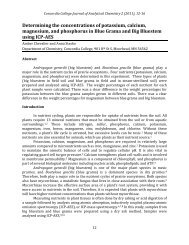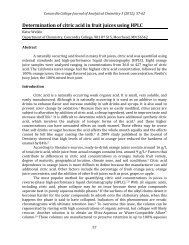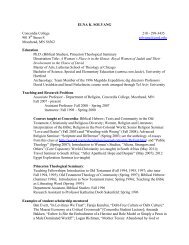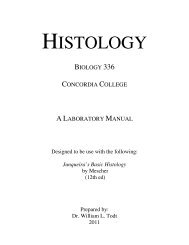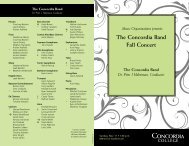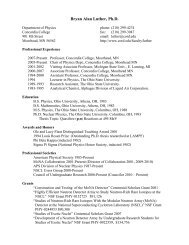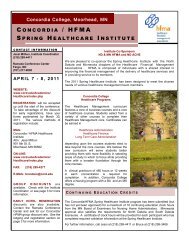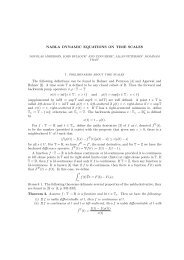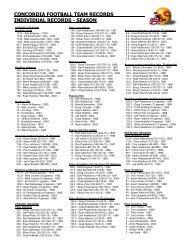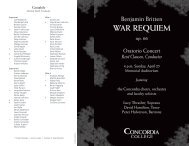Djembe - Concordia College
Djembe - Concordia College
Djembe - Concordia College
Create successful ePaper yourself
Turn your PDF publications into a flip-book with our unique Google optimized e-Paper software.
36<br />
Vivid descriptions aid all students who travel. Even though sighted students can see<br />
objects whizzing by windows for themselves, if they are awake, the descriptions help students<br />
process more fully what they are seeing and also give them a vocabulary for relating their trip<br />
upon their return. Teachers, however, need to be cautious not to talk too much. A good rule of<br />
thumb is to name and describe whatever students cannot fully understand by simply looking.<br />
For example, when passing a forest it does not help to note that there are a lot of trees outside. It<br />
is useful, however, to point out what type of trees there are as you give the characteristics of the<br />
foliage, etc. Information concerning the cultural significance of forests, e.g. issues concerning<br />
acid rain, medieval livestock practices, and other facts can also be useful. Likewise any historical<br />
data, e.g. an explanation of the name of the forest or famous historical events that took place there,<br />
makes the forest even more memorable. Names and historical or cultural information about castles,<br />
cathedrals, buildings, areas, cities, mountains, and the like all can be very enlightening. When one<br />
encounters long stretches of similar scenery, this can be a good time to discuss other cultural<br />
and historical information about the country you are passing through, and how the terrain of a<br />
particular place is reflected in the identity of a nation. For example, Iceland’s cultural identity as<br />
a nation is profoundly affected by its geography, namely as a barren and ruggedly beautiful island<br />
in the cold north Atlantic, as is Germany with it’s lush green forests and castle laden countryside.<br />
At times a helpful exercise can be to have students describe to each other what they are<br />
seeing. This forces them to think about a historic and cultural objects or pieces of breathtaking<br />
scenery in a new way and takes the burden off instructors to keep this up for a month. In<br />
preparation for our trip, students had to pick a country and cultural area and an historical site to<br />
give presentations on. Students were at times encouraged to keep in mind non-visual ways of<br />
describing their sites. Descriptive language requires creativity and not all people are equally adept<br />
at it; it takes work and creative energy.<br />
Even when the group is not traveling, visually descriptive language is essential.<br />
Descriptions should include size, shape, texture, a sense of the surroundings, and a language of<br />
concrete comparison to familiar objects. For example, when the students first saw an Irish monastic<br />
tower, one instructor described it as a fat pencil with the eraser end planted in the ground and the<br />
sharp point sticking up into the sky about 100’. The instructor continued, “The tower is made<br />
up of rough hewn rectangular rocks, with each block being slightly curved and 2’ by 4’.” At this<br />
point, the teacher had Claire touch the blocks in order to feel its size and texture. Without further<br />
prompting, most, if not all, of the other students did the same. Then he walked Claire around the<br />
tower counterclockwise, having her put her left hand on the tower itself in order to give her a<br />
sense of its circumference, which was roughly 100’ or so; other students followed suit without<br />
prompting. Claire immediately noticed one of the features of such towers with this exercise, “But<br />
where’s the door?” The instructional moment had occurred without sight. The instructor explained<br />
that the towers have no doors at ground level. Rather the lowest door first appears about 20’ up.<br />
The reason for this is twofold. First, some scholars think that a door at the bottom would have been<br />
structurally unsound and it would contribute to the early collapse of the tower. Second, monks<br />
and nuns, when attacked by Vikings, would put a ladder up to the door and they, along with<br />
all their valuables and food, would climb up into the tower and pull the ladder up after them,<br />
bolting the door securely behind them. Hence they and their belongings were safe inside from the<br />
raiders. Then the instructor could also point out that the towers were freestanding, generally a good<br />
distance away from other buildings and hills.<br />
Some realities, however, are not so easy to explain. For people who have been blind<br />
from birth or early childhood, the notion of color, light, and shadows are harder to grasp. While<br />
offering Claire a hands-on walking tour description of the construction and function of Stonehenge,



